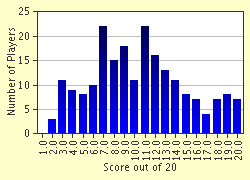Quiz Answer Key and Fun Facts
1. The action of "Richard III" directly follows the events of which of these historical dramas?
2. Many have argued that the negative image of Richard, as presented in this play, is the result of historical distortion by scholars in the employ of the Tudor family. One of the most prominent of these was Sir Thomas More, whose unfinished "History of King Richard III" was probably known to Shakespeare. More, as it happens, had once been a page in the household of one of the characters in Shakespeare's play; which character was it?
3. The play opens with Richard's famous speech beginning "Now is the winter of our discontent made glorious summer by this Sun of York." The device of having the play begin with the protagonist thus addressing the audience was used in none of Shakespeare's other plays besides this one.
4. The first of Richard's many victims in this play is his own brother, the Duke of Clarence. Richard has exploited King Edward's concern about a prophecy stating that his issue shall be disinherited by a mysterious entity known only as "G". What is Clarence's first name?
5. With astounding audacity, Richard pays court to the widowed Lady Anne, whose husband and father-in-law had died by his own hand. When Richard approaches her, Anne is following the bier of her murdered husband, Edward.
6. Although there are many historical inaccuracies in the play, the presence of one character in particular is most unhistorical, as he/she had died in 1482 and, prior to that, had been in exile in France. Which character is it?
7. Queen Margaret praises this character, but then prophecies an unhappy end for him after he rudely rebuffs her; a prophecy he remembers shortly before his execution. Which character is it?
8. Before his murder, the Duke of Clarence relates to his jailer a vivid nightmare he had had the night before in which he drowned. According to the dream, how did he come to drown?
9. This animal is associated with Richard in the play and was, in historical fact, featured on his crest. What animal is it?
10. In Act III, scene III, Rivers, Grey, and Vaughan are being led to their execution at Pomfret castle, also known as Pontrefract. This castle had previously been the scene of the death of a king of England, also the subject of one of Shakespeare's historical plays; who was it?
11. Which fruits does Richard request from the garden of the Bishop of Ely in Act III, scene IV?
12. Lord Hastings is, perhaps, the unluckiest of Richard's many victims; he is sent to his death for uttering a single, monosyllabic word. What is the word?
13. In Act IV, scene I, Queen Elizabeth, Lady Anne, and the Duchess of York commiserate over the imprisonment of the two Princes in the Tower. At the end of this scene, the Queen makes an extremely moving speech entreating mercy for her children. To whom, or what, is this speech addressed?
14. In Act IV, scene II, Richard ascends the throne. No sooner does he take the seat of power than he obliquely, but unmistakeably, orders the deaths of his two nephews. He also intimates to Catesby that another victim will soon fall; who is it?
15. Act IV, scene IV begins with Queen Margaret, Queen Elizabeth, and the Duchess of York reciting a litany of the various children and loved ones they have lost. In this scene, what favor does Queen Elizabeth ask of Queen Margaret?
16. By whom is Richard memorably cursed in the middle of Act IV, scene IV?
17. Act IV, scene IV also contains a quite lengthy scene between Richard and Queen Elizabeth. What proposition does he make to Elizabeth during this scene?
18. Act V begins with the execution of Buckingham; what highly significant feast day does Buckingham's execution fall on?
19. In Act V, scene III, Richard is cursed by his many victims. These include Prince Edward, son of Henry VI. Which other character in the play dreamed of Edward before his death?
20. Which of Shakespeare's histories chronologically follows the action of "Richard III"
Source: Author
jouen58
This quiz was reviewed by FunTrivia editor
agony before going online.
Any errors found in FunTrivia content are routinely corrected through our feedback system.

